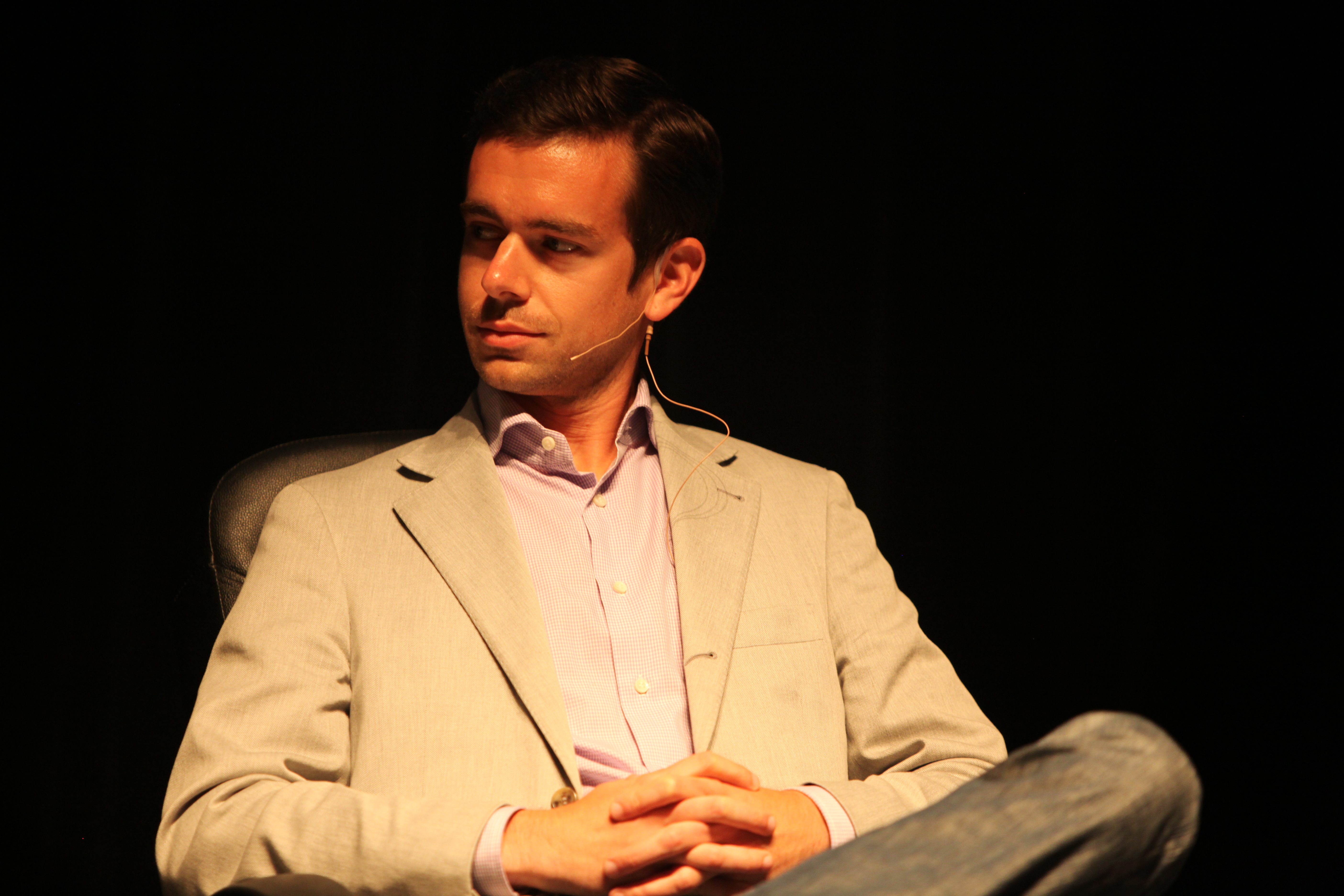Part two in a four-part series on innovation and change as the new schools of business management…
Jack Dorsey is the co-founder of Twitter and Square. He has since rejoined Twitter as Executive Chairman and will focus on product development to further Twitter’s mainstream appeal. He also remains CEO of Square. What follows is my uncut interview with Dorsey for a recent Entrepreneur Magazine cover story.
Maybe you have to have helped conceive Twitter to be bold enough to take on a change-resistant industry like the financial sector. That’s what Jack Dorsey, a co-founder of the ubiquitous 140-character phenom, is doing with his newest endeavor, Square. It aims to transform any mobile device into a credit card reader, allowing any business to accept credit cards and process transactions in less than 10 seconds. Dorsey’s simple vision is to make payment systems more accessible. Two great ideas…two great companies.
Sarah Lacy, Silicon Valley pundit and Web 2.0 author, once noted of tech entrepreneurs, “Once you’re lucky, twice you’re good.” Such is true for Jack Dorsey. Perhaps Mr. Dorsey isn’t a household name yet like say, Mark Zuckerberg. But, that’s all about to change. Jack is the co-founder of a fledgling startup that you may have heard of. Along with Biz Stone and Evan Williams, Dorsey co-founded microblogging sensation Twitter in 2006. The idea was unconventional in its inception, but pioneering in its capacity. Not only has it changed how people share information, it is changing how people create and consume information, 140 characters at a time.
Before Twitter hatched, Dorsey’s lifework focused on developing dispatch software to track ambulances and taxis to visualize where they were and what they were doing. As he’ll tell you, he fell in love with visualizing cities to uncover what did and didn’t work and also how to invent solutions to streamline the system.
In 2000, Dorsey realized that his work was missing something vital to these cities, the very citizens who populated them. Like ambulances and taxis, he wanted to better understand where his friends were and what were they doing. His vision was to capture and share experiences in the moment, “If I were in the middle of Washington Square Park, I could share the experience in real time using a mobile device. But in 2000, it was a bit too early, and the idea didn’t work out so well.”
Dorsey put the idea to rest. Fast forward five short years. As always, technology marches ahead and by 2005, advancements in mobile communication and adoption set the stage for idea 2.0. At the time, SMS was taking off in the U.S. and was already widely adopted in Europe and around the world. By 2006, it was time to revisit his plans and introduce the world to the live web.
Tweet This: An Idea Reborn
At the time, Dorsey was employed by Odeo, a podcasting company where Evan Williams was an investor and founder. For those who don’t know, Williams was the inventor of not only the term “blogger” but also was the founder of the weblog authoring web applications of the same name. It would eventually sell to Google and the proceeds of that deal would lay the foundation for Twitter. Unlike the success Williams found at Blogger, Odeo was on a path toward uncertainty. The team sought the next big thing and during what is now considered a revolutionary series of deep company soul searching, Jack presented his concept for “my.stat.us.” The idea was to text message what you were doing and have a group of friends follow along. What was once a system for tracking ambulances and taxis would now set the stage for creating a dispatch service that connected people through their phones and text messaging.
Odeo embraced Jack’s idea and dedicated staff and resources to developing version 0.1. My.stat.us eventually was code-named twttr, inspired by the Yahoo-owned social photo network Flickr as well as the fact that American shortcodes are five characters long. Eventually named Twitter, the micro-blog as it was originally referred to, would combine mobile and web services, and limit communications between its users to 140 characters with each message. Jack found that the constraint of 140 characters was actually easier to approach and thus reducing the barriers to entry. Messages evolved into “tweets” and suddenly, everyone with a phone or computer represented a potentially new connection.
Don’t Call it a Social Network: Twitter as an Information Network
But Twitter quickly evolved into something much more than a messaging or friend tracking service, it became a medium for reporting experiences to highly connected audiences. “Twitter is about simplicity. The constraint of 140 characters is easy to approach and consume, without a great deal of barriers to entry. One message and suddenly the whole world has access to that Tweet.”
Jack’s idea for Twitter is also transformative in that it’s not designed to be a social network, but instead it serves as a raw utility. It was unique in terms of how people approached and defined it and as Jack described, “there wasn’t a lot of product definition around it. People could report about the earthquakes they just felt, what they had for breakfast, and each time they Tweet, it sparks interaction.”
The evolution of human communication was introduced to a new branch off the main road. Tweets now served as the impetus to engender reactions that would lead to responses, Retweets (sharing the Tweets of others), memes (threads dedicated to the subject), and also real world, face-to-face interaction. Each time, these exchanges further relationships in any given direction.
But Jack’s vision also proved to have a dramatic near-term impact on human connections that’s quite literally making the world not only a much smaller place, but also more empathetic.
The 2009 election in Iran was forever immortalized because of Twitter. It served as the catalyst for humanizing the experiences of real people during times of political and civil unrest. The whole world watched as Iranian people took to services like Twitter to voice their emotions and share snapshots of everything the Iranian government tried to suppress. Twitter became a platform for protests. In just a few years, Twitter had also emerged as a global network for spreading news and events, as they happened, much faster than any news network could report. From dispatch to My.Statu.s to Twttr to Twitter, Jack’s vision essentially created a real-time system for tracking the pulse of a global community and the experiences of everyday people.
“The more we share what’s happening around us, the more we understand how someone lives their life. The greater the understanding we have, the more empathy we have for each other. By and llarge, that reduces conflicts. When you have an understanding of how someone else lives, the less likely it is that you conflict with them.”
Fitting a Square Peg into A Round Hole
Sometimes lightening strikes twice and with Jack, the unique combination of financial crises, the ability to spot opportunity, combined with a little luck, would prove fortuitous.
Jack was set to disrupt an industry impervious to the constant pace of Silicon Valley innovation, the financial sector. In order to do so, he credits three takeaways he gleaned from his experience at Twitter:
1. The concept of immediacy helps bring people into the content and encourages personal publishing and resulting subscriptions
2. Being transparent about what’s happening makes exchanges and transactions more human
3. As a result, we are creating a dynamic where people and organizations are inherently more approachable.
These three lessons would serve as the foundation for targeting the financial world, as he observes, “The financial world has long been missing immediacy, transparency, and approachability and this is what’s needed now.”
As with many ideas, necessity serves as the mother of invention. Jack’s partner and co-founder Jim McKelvey is also an accomplished glass artist. But because he could not accept credit cards as payment, he was unable to sell his work to meets its true potential. Discouraged by the arduous and intimidating process of accepting payments via plastic cards, Dorsey focused on developing a solution that worked for everyday people who also happened to run businesses of varying size and scope.
Indeed, payment systems were in dire need of access and incorporation to keep pace with the evolution of commerce. Jack envisioned an idea where payment systems would become approachable, sociable and actionable. And thus, Square was born, ironically, next door to the old US Mint in San Francisco.
Innovation in a Time of Financial Crisis
They say timing is everything and certainly Dorsey would agree. At the time Square was coming to life, the financial industry was experiencing a meltdown, and while it was a painful experience for many, it also opened the doors to opportunities for innovation and new partnerships.
“At the end of 2008 and in early 2009, the market was resetting itself with the clearing of existing management teams across the board. MasterCard and VISA were under a serious microscope by the Federal Government, So everything was in place to do something. We were able to quickly move in and talk to the right people in order to do some very interesting things quickly.”
Square was the merging of several important elements: technology, mobile, social, and financial.
90% of the world uses plastic cards to pay, but only about 2% of merchants can accept them. Since a sweeping majority of consumers rely on cards, Square was faced with the challenge of replicating the simplicity on the receiving end. The team set out to transform payments to create as Dorsey describes, “A magical experience around payments and what it means to pay people. Innovation could impact everything, making payments, faster, richer and more information dense as well as actionable and memorable.”
Creating a Magical Experience Around Payments
Jack looked to Apple’s in-store payment network when designing the Square experience. Rather than forcing people to stand in line behind a cash register, he appreciated the process of swiping a card right at the moment of decision. Thus, he set out to extend that “magical” experience to everyone.
Starting with the technology, Square set out to completely reinvent the payment processing system by aligning with important trends in the adoption of consumer electronics. Smart phones are pervasive, propelled by the likes of Apple’s iPhone and Google’s Android. On the horizon, tablets, such as the millions of Apple iPads already on the market, were set to disrupt mobile computing. The one thing each shared in common would set the stage for Square and an unlikely form of innovation for the payment services industry, the standard 8mm headphone jack.
Square is the size and shape of a sugar cube and features a small opening that houses the ability to read a card once swiped. The cube includes a plug that resembles that of a regular pair of headphones and plugs directly into the headphone jack of the mobile device. Combined with the Square software app, phones and iPads essentially transform into mini card processing centers. With each swipe, money is deposited into the individual’s Square account with modest fees extracted, and is there for future use or simply to transfer into the designated bank account.
Out of the gate, Square works with any US-issued credit, debit, pre-paid, or gift card with a Visa, MasterCard, American Express, or Discover logo.
Accepting payments is just the beginning however, as Dorsey and the Square team envision payments as catalysts for social and actionable interactions. Everything begins with receipts. Print receipts aren’t actionable. Such is true with electronic receipts. Square believes that there is life after the transaction as Dorsey asks, “What if you could actually browse the receipts?”
His point is that the receipt will move beyond that of a static record. The receipt becomes a platform for extending experiences and facilitating the exchange of information and communications during and after the sale, between the people on each side of the transaction. The acts of quickly and easily paying or receiving payments is just the beginning. Square seeks to improve the dynamics and relationships between businesses and their customers.
The examples he shares are as interesting as they are practical. “When you get home, the receipt could serve as an ingredient list to discover the blends that went into your espresso, to see how many times you’ve been to that particular location, used a loyalty or rewards system, click into a merchant’s Twitter or web site, forward the receipt for expenses, and see, through a beautiful visual, where the transaction took place.”
Twitter is the Internet’s rising star with 200 million people sending over 140 million tweets every day. Jack’s vision is now in reality, transforming culture, business, and media with every Tweet that flies. And with Square officially live, Jack is going up against not just one, but several Goliaths. These industry giants though, can’t deny the ingenuity and outside-in innovation Dorsey introduced into an aging industry that so desperately needed it.
Change and innovation, two pillars of business that open the doors to new opportunities. Everything begins with imagination, the vision to see things differently and the passion to connect your idea to the people who will benefit from it. What are you working on?
Watch this video on Dorsey at Entrepreneur for more insights…
Introduction: The Innovator’s Dilemma
Part 1: Jack Dorsey, Twitter and Square
Part 2: Zappos’ Tony Hsieh Delivers Happiness Through Service and Innovation
Part 3: Dennis Crowley, FourSquare
Connect with Brian Solis on Twitter, LinkedIn, Facebook
![]()
___
The New ENGAGE!: If you’re looking to FIND answers in social media and not short cuts, consider Engage!: Choose from the Deluxe or Paperback edition

___
Get The Conversation Prism:







“Once you’re lucky, twice you’re good” (Sarah Lacy) and ‘Twitter is an information network.’ Very key points and one of my favorite Brian Solis posts yet. The next 6-18 months will be very interesting in defining how this all matures and extends into different areas.
Ian, thank you. This entire series is written with a passion to help others find what they need to do what they’ve desired to do for so long….
Good post Brian. I find any article that looks at the best tech entrepreneurs fascinating. Dorsey is clearly man who finds simple solutions to problems many people didn’t know existed and knowing that he is back at Twitter pleases me.
Keep the articles coming. I look forward to the next in the series.
Wow! Very good post Brian. Looking forward to the last two parts of your series. Really enjoy reading your posts.
I love the three lessons of immediacy, transparency, and accountability. They seem so obviously important to any strategy, yet we rarely witness all three in harmony. Regardless of industry, the future definition of success is going to encompass these ideas.
Fascinating stuff, Brian. Is Square also looking at micro-credit?
Nice profile Brian!
Although, I tend to wonder if the part about Twitter not having a lot of product definition isn’t a bit revisionist. The site evolved yes – but numerous were the times that product changes were made that went against the grain of how the users were using it. Heck, even the existence of a “suggested follow list” at one point in time indicated that Twitter had ideas about how it “should” be used rather than adapting to how it *was* being used.
But it’s history now, and it sounds like Jack is focusing on the future – which can only be good news for the rest of us.
Twitter as an information network? … uhmmm I am not sure about that, however the ideas that you describe in your article are very informative, the internet is changing in a silent revolution
Great profile. Very informative and well written (as we have all come to expect from Brian). Jack is an interesting and innovative person, and profiles of him are usually very interesting to read (like the Vanity Fair profile in addition to this article). I’m always curious to see what Jack’s working on.
Great article and series. I especially appreciated Jack Dorsey’s three Twitter takeaways – immediacy, transparency, and approachability – which create a good foundation for most any industry or business strategy, but is all-too-often hampered by red tape, regulatory restraints, and lengthy review processes.
Yay Jack Dorsey!
BTW. This article really helped, and I thank you.